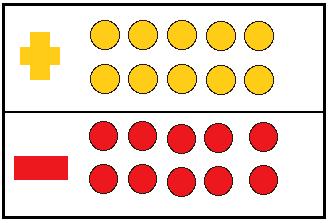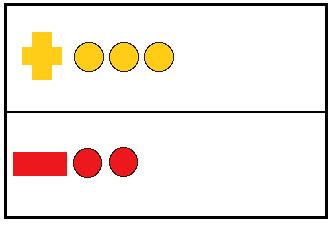Subtraction with Counters
|
Introduction
In this unit we describe how to teach subtraction in the first grade using two-color counters. We also show how to introduce and explain negative numbers at this level. The Board The plus and minus signs should be very prominent, in colors that match the colors on the two sides of the counters. For example, if the counters are red on one side and yellow on the other, the plus sign on the board should be yellow and the minus sign should be red. When children put counters on the upper part (+) of the board, the yellow side must be up, and when they put them on the lower part ( - ) the red side must be up. 
Here's an example in which three yellow counters and two red ones are on the board:
This is the presentation on the board for subtracting 2 from 3. To perform subtraction, we have to remove two counters at the same time, one red and one yellow. After we finish we have the answer, one.
Here's what it looks like on the board:
When we subtract, there are three possible outcomes.
We are left with minus one, namely with one "to be subtracted." (See activity 5 below.) Activity 1. Children are given precut pieces of poster board. Using rulers, they draw a horizontal lines to divide their boards into two equal parts. They draw the plus and minus signs with colored markers, and decorate the back side of the board. So each child will own one board, to be used in further activities. 2. Simple subtraction of a smaller number from a bigger one. 3. Subtraction of equal numbers; zero is the result. 4. A chain of additions and subtractions. An example: 5 - 3 - 1 + 4 - 2 = 3 The teacher gives instructions orally, one number at a time. Children perform the operations and say the answers.
Students say: "Five minus three is two, minus one is one, plus four is five, minus two is three. 5. Introduction of negative numbers. ** In a chain of additions and subtractions, some partial results may be negative. Children should learn how to read them, minus one, minus two, ..., but the process of computations does not have to be interrupted. An example. 3 - 4 + 2
Students say three minus four is minus one, plus two is one. In this context, children learn one of the main possible interpretations of negative numbers. They are numbers waiting to be subtracted. This meaning provides the main use of negative numbers in financial transactions. Negative numbers represent debts which must be subtracted from future deposits. 6. The board can be used for other purposes, such as one-to-one matching, but the color scheme (yellow counters on the top, red on the bottom) should be preserved in order to avoid confusion. 7. Introduction of calculators. After children get proficient with the board, they should compare the results of their computations with the values obtained from a calculator. Children should not be "checking" their answers. They should be learning that the same operations, addition and subtraction, can be performed with different equipment, either manipulatives or calculators. ** Historical Remark This interpretation of negative numbers can be found in the first edition of the Encyclopaedia Britannica in the chapter on algebra. "Thus the quantity represented by a , + a imports that a is to be added, or represents an increment; but - a imports that a is to be subtracted, and represents a decrement." (Encyclopaedia Britannica, Volume I, page 80. Printed in Edinburgh by A. Bell and C. Macfarquhar in 1771.) Lesson Index |


